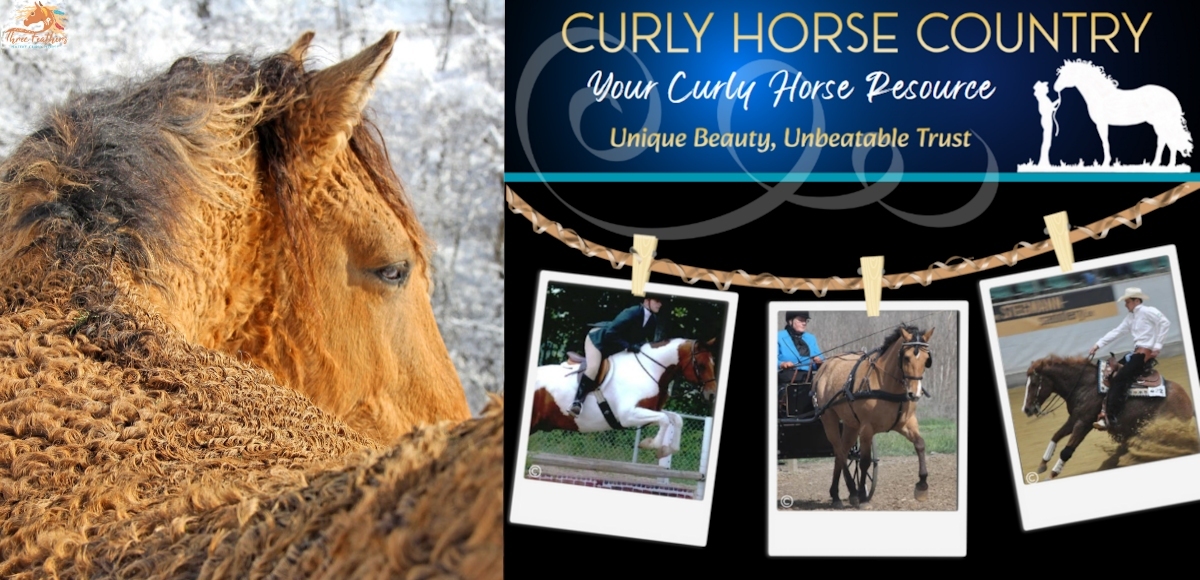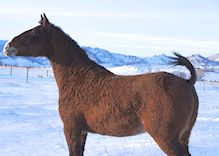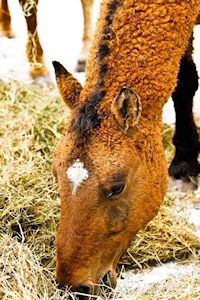Extreme Curly Horses - Coat Care, Environment & Nutrition
(Click here to view a great explaination of what we mean by "Extreme")
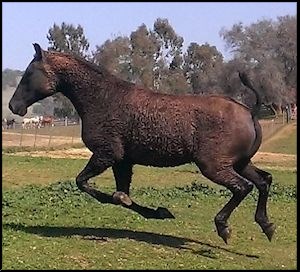
Photo Courtesy of Circle H Curly Ranch
"Extreme Curly Horses" - Maybe you have never heard that term. But the term 'Extreme" was used to identify a specific group of curly horses that appear to demonstrate the extreme side of the curly characteristics. Curly Coat, calm & gentle disposition, shedding of mane & tail etc. Most extreme curly horse owners, would never want to own any other type. As they have proven to be trustworthy beyond compare, dosile and very friendly. Many are used for youth, therapy or handicapped programs. With regard to their coat, mane and tail, most curlies may shed "a small part" of their manes & tails in the summer, but grow back a very thick curly hair in the winter time. Extreme curlies tend to shed alot of their coat, mane and tail, while growing back very little of it in the winter time. Some extreme curlies may even shed some of their summer body coat exposing skin. Research has been prompted to determine what it is genetically that brings about these extreme traits. But until then, those that own them absolutely adore them and only hope to find some remedy & help to making these special curlies comfortable in all seasons.
And SO, this article was written. In the past few years, questions about the coat care of extreme curlies has been at the top of the list.. Questions such as: " My extreme curly has bare spots on his chest, neck, and shoulders. Any thoughts as to how to treat this?" or "How do I keep my extreme curly comfortable in the heat and bad fly season"?
Maybe you have asked that same question, which is how you ended up finding this page. If so, I hope the advice and help found in this article are encouraging.
Coat Patterns of the Extreme Curly
If you own an extreme curly, you may have found their body coat sheds to expose skin in areas of the neck, face, shoulders, rump and flank. You may also see bare patches on their rump due to the tail swishing at flies and this created what we all call "thwark marks." Thining hair is often times more noticable in the summer months, once the curls shed out, but some owners report that if their curly rubs consistently on a feeder, stall door, or various other things during the winter months, their hair simply 'rubs out." Leaving bald patches mainly on neck and shoulders.
Horses rely on their body coat for protection from the elements; ie cold in the winter and flies & heat in the summer. So it's easy to see why owners would be concerned when their curly loses their body coat for any reason.
One breeder remarked that if you want a really nice coat on your extreme curly, you "can't let them SIT & FORGET. They require maintaince." In deciding to write this article, I found it best of course to consult with extreme curly horse owners for their advice, input and testimonals in caring for their curly and maintaining the best possible skin & coat for these horses. Keep in mind that should you decide to use any suggestions found in this article, there are no guarentees and we suggest consulting your veterinarion when attempting any new product or suppliment with your curly horse.
ENVIRONMENT: The first thing we all agree upon is that the hair of the extreme curly is typically very coarse and also very vulnerable to breakage and damage. So the first suggestion we will address is environment. If possible, do not use standard feeder rings that are at chest level that allow rubbing when your horse eats. If he/she tends to lean over a stall door, causing hair breakage, either protect that area with sheepskin or fleece, or raise the door to a level they can't rub. Be sure to have adequate shade for your extreme curly. A cool place where he/she can return on those hot summer days. Extreme curlies do not do well with any kind of fly sheets because the constant rubbing tends to break off more hair. If a fly sheet is NECESSARY, be sure to use it short term and buy one that is a REALLY soft mesh with protected edges to reduce rubbing. Spending extra money on a quality Fly spray is essential with any horse, but especially with an extreme. Suggestions were: Konk Ultimate Repellent for BARN USE, and Endure Fly Spray for horse body use. Most important though is cool, dry shelter is a must in the summertime. Not only to maintain a healthy coat but it's very important for their personal comfort. SanteFe coat conditioner and sunscreen was also recommended. .
COAT CARE: Second, be sure to eliminate any physical reason your horse may feel the need to rub, ie itchy skin or allergy related causes. You can start by giving your curly regular EQUIDERMA baths. Keep the skin clean and healthy and be sure to rub gently. In the testimonals below you will get suggestions of products others have tried that will also keep the skin and hair healthy using external products. Including shampoos, rinses and certain brushes. Another is Protected Equine Antibacterial scrub
NUTRITION & SUPPLIMENT SUGGESTIONS: There is a theory that the extreme curly is lacking in certain vitamins and/or minerals and so their extreme shedding pattern exists. Some feel its a lack of sulfer. Others zink or omega fatty acids. In any case, many have found additional suppliments helpful and even swear by them. One product is Command Coat and Hoof. As you will see in the below testimonal one owner suppliments with MSM, not for the anti-inflammatory properties but for the sulfur content which she feels is lacking in the extreme curly. Also another recommendation is biotin and ground flax.

TESTIMONIALS:
Thank you to Janeen & Norma for your suggestions and helpful tips!
(From Libby) I put our curly mare Susse on the powdered form of coca soya oil - I used the powdered coca soya because it didn't have as much veggie oil as the oil did which was giving her diarrhea.. I also put her on smart hoof from smart pak which has the extra omega 3 in it. The smart hoof was because of our Climate she was not growing good hoof because it's constantly cold and then warm and has helped with cracking and helped her skin with the omegatin it has in it. But as a trail rider it has helped.Then I put her on the bug off which doesn't work other than for her coat as it has more probiotics in it. But does not repel flys. The bug off took a couple months before it started to work so I suggest starting it just before or beginning of spring so it will be working by the time the bugs come out.I also found that MTG worked really well for hair growth and did not burn her. I put it on twice a week and the hair just started growing! The only problem I still have is when she swats flys her hair is still brittle and when her tail hits her rump it breaks the hair off.
| Before |
After |
 |
 |
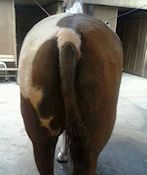 |
 |
| Pink skin showing bare spots in her coat |
No more pink skin! |
Sussie After Libby's Treatments

________________________________________________________
(From Mindy - www.theessentialhorse.com ) Billy blaze is an extreme curly and i have found that the best brush for his coat in the winter time is a pin brush. the other brushes all cause static electricity and then we shock each other! i get my brush, called the hedge hog from here:
http://www.horsewellness- store.com/proddetail.php?prod= 188%2FK%2Fgew
i also do not skimp on the fly spray in the summer time. Billy is in with another horse with a regular mane and tail and she graciously shares her tail with him :) but having an effective fly spray has been his saving grace. i supplement with a natural fly spray that i make myself, but found that for the really bad biting bugs a chemical based spray is necessary. i love the Bronco brand, but recently i bought the Repel X concentrate brand. they didn't have the Bronco brand ;)
Billy doesn't sunburn so i don't have any advice for that part! i have a few photos that show him in his winter coat and then in his summer coat. he usually sheds his front end first and i have people always ask me why i've clipped his head and neck ;) but he just starts there and the shedding moves back. by the beginning of july he has usually shed his mane and tail completely.

________________________________________________________________
(From Blaine) 1. treat with dermal aid, even if it won't help the hair grow it does remove the itching factor 2. He has a full face fly mask on 24-7 just an easy way to protect one part so he isn't fighting those flys on top of all the others 3. I don't brush him often....sounds bad but they roll in dirt to help keep the flys away plus I think it removes the fly spray 4. I fly spray every other day or when needed. I don't buy the cheap stuff cause it doesn't work. Ultra shield in the black bottle is the only one that seems to work. 5. It helps if your pasture is out in the open away from the woods. We get a nice breeze almost daily which helps with the flys. 6. Shade. 7. If he lost body hair I'd put a full body fly sheet on him. They are suppose to help with the sunrays. There also is a sunscreen for horses which works if you are consistent. I had a palomino that also got sunburnt on his muzzle and it helped a lot.

______________________________________________________________
(From Tall Trees Curlys) Lots of extra minerals/vitamins/hay/salt /water and good feed puts lots of
curls on them for the winter.
If you would like to share your experience with your extreme curly. Please email curlyhorsecountry@yahoo.com - we would love to hear from you!
